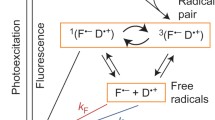Abstract
Studies of Pacific Ocean dog salmon fry of the species Oncorhynchus keta addressed two retinomotor reactions: after transfer of fish from the dark to the light and after placing fish in the field of a permanent magnet (magnetic induction, 80 G) in complete darkness. The reactions of photoreceptors and the pigment epithelium (PE) to the magnetic field were analogous to those of the retinal reaction on adaptation to light. The morphological characteristics of photoreceptors and retinal PE cells lead to the view that the effect of the field of a permanent magnet on the retina of young dog salmon is comparable to that of light.
Similar content being viewed by others
References
E. O. Zagal’skaya, V. P. Gnyubkina, and A. A. Maksimovich, “Morphological characteristics of the retinomotor reaction of young Oncorhynchus masou salmon trout in magnetic fields and red light,” Morfologiya, 125, No. 2, 47–51 (2004).
A. A. Maksimovich, A. A. Kudra, and V. M. Serkov, “Morphological changes in the retina of young Oncorhynchus masou salmon trout in experimental changes in the geomagnetic field,” Tsitologiya, 44, No. 2, 140–150 (2002).
M. A. Ali, “Photoreceptor ultrastructure of light-and dark-adapted young, pigmented and adult, silver eels, Anguilla anguilla (Pisces, Teleostei),” Zool. Anz., 219, 230–238 (1987).
M. A. Ali, M. A. Klyne, and P. E. Einarsson, “Ecophysiological adaptation of the retina in the arctic chars,” in: Retina, University of Manitoba Press, Winnipeg (1984), pp. 252–261.
M. A. Ali, W. R. Stevenson, and J. S. Press, “Histophysiological studies on the juvenile Atlantic salmon (Salmo salar) retina. 1. Rates of light-and dark adaptation,” Can. J. Zool., 39, 123–128 (1961).
M. A. Ali and H.-J. Wagner, “Visual pigments: phylogeny and ecology,” in: Vision in Fishes. New Approaches in Research, Plenum Press, New York (1975), pp. 481–516.
I. N. Flamarique and C. W. Hawryshyn, “Retinal Development and visual sensitivity of young Pacific Sockeye Salmon (Oncorhynchus nerka),” J. Exptl. Biol., 199, 869–882 (1996).
He Daren and Zhang Houquan, “The mechanism of retinomotor movements in the retina of banded grouper (Epinephelus awoara),” Acta Oceanol. Sin., 11, 611–615 (1992).
D. M. Higgs and L. A. Fuiman, “Light intensity and schooling behavior in larval gulf menhaden,” Anat. Rec., 252, 453–461 (1996).
T. P. Quinn, “Evidence for celestial and magnetic compass orientation in lake migrating sockeye salmon fry,” J. Comp. Physiol., 137, 243–248 (1980).
T. P. Quinn, R. T. Merril, and E. L. Brannon, “Magnetic field detection in sockeye salmon,” J. Exptl. Zool., 217, 137–142 (1981).
M. Zaunreiter, R. Brandstatter, and A. Goldschmidt, “Evidence for an endogenous clock in the retina of rainbow trout: I. Retinomotor movements, dopamine and melatonin,” Neuroreport 9, 1205–1209 (1998).
Author information
Authors and Affiliations
Additional information
__________
Translated from Morfologiya, Vol. 132, No. 5, pp. 43–47, September–October, 2007.
Rights and permissions
About this article
Cite this article
Gnyubkina, V.P., Maksimovich, A.A. The retinomotor reaction of the retina of young dog salmon Oncorhynchus keta on adaptation to light and the field of a permanent magnet. Neurosci Behav Physi 38, 867–871 (2008). https://doi.org/10.1007/s11055-008-9058-6
Published:
Issue Date:
DOI: https://doi.org/10.1007/s11055-008-9058-6



